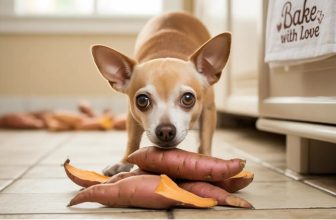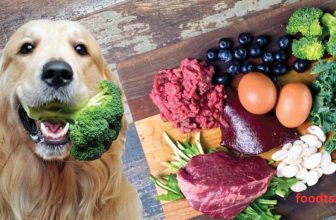Can Dogs Eat Food With Garlic? Expert Warnings & Tips

Can Dogs Eat Food With Garlic? The short answer is no—garlic is harmful to dogs. While we enjoy garlic in many dishes, it can damage your dog’s red blood cells and lead to anemia, weakness, or even serious health issues. Some pet owners believe garlic helps fight off fleas or ticks, but the risks far outweigh any benefits. It’s important to know which foods are safe and which ones can harm your furry friend. In this post, we’ll explain why garlic is unsafe and suggest safer, dog-friendly alternatives to keep your pup healthy and happy.
Garlic And Dogs
Garlic is a common ingredient in many human dishes. But is it safe for dogs? Understanding the relationship between garlic and dogs is vital for every pet owner. Some foods are safe for humans but not for our furry friends. Garlic falls into this category. While small amounts might not harm, larger quantities can be toxic. This blog post explores the effects of garlic on dogs and provides insights into its different varieties.
What Is Garlic?
Garlic is a plant from the Allium family. It is related to onions, leeks, and chives. Known for its strong smell and taste, garlic is a staple in many cuisines. It is used to add flavor to dishes. But what makes garlic unique? Here are some key features:
- Bulbous plant: Grows underground in a bulb-like shape.
- Cloves: Each bulb contains several cloves.
- Pungent aroma: Strong smell, especially when chopped.
- Health benefits: It contains compounds with potential health benefits for humans.
Garlic is often used in food and medicine. It is known for its antibacterial and antioxidant properties. But despite its benefits for humans, garlic can be harmful to dogs. The same compounds that benefit humans can be toxic to dogs.
Garlic Varieties
Garlic comes in different varieties. Each variety has unique characteristics. Understanding these can help in identifying their potential effects. Here are the most common types:
| Variety | Description |
|---|---|
| Softneck Garlic | Mild flavor, common in supermarkets. Lacks a central stalk. |
| Hardneck Garlic | Stronger flavor, has a central stalk. Better for colder climates. |
| Elephant Garlic | Larger cloves, milder taste. Not a true garlic, closer to leeks. |
Each type of garlic can affect dogs differently. Hardneck and softneck are typical in cooking. Elephant garlic is less common but used in some recipes. Knowing these can help avoid any accidental ingestion by dogs.
Potential Risks
Dogs are curious creatures and love to explore different foods. Garlic is a common ingredient found in many human dishes. But can dogs safely consume garlic? Understanding the potential risks involved is crucial for every dog owner. Garlic contains compounds that might not be safe for dogs. Knowing how garlic affects dogs can help in making informed dietary decisions.
Toxicity Levels
Garlic can be toxic to dogs. This is mainly due to compounds called thiosulfates. These compounds can damage red blood cells. This leads to a condition called hemolytic anemia. Here are some important points about garlic toxicity in dogs:
- Thiosulfates found in garlic are harmful to dogs.
- Small amounts might not cause immediate harm, but can be dangerous over time.
- Higher doses can lead to serious health issues.
It’s essential to understand the difference in toxicity levels between garlic and other foods. Garlic is more concentrated than onions. This makes it more toxic to dogs. The table below illustrates the potentially toxic dose of garlic for dogs:
| Dog Weight (lbs) | Potentially Toxic Dose (grams) |
|---|---|
| 10 | 2 |
| 20 | 4 |
| 30 | 6 |
Symptoms Of Garlic Poisoning
Garlic poisoning in dogs can show various symptoms. These symptoms might not appear immediately. They can take several days to develop. Knowing these signs can help in early detection:
- Vomiting and diarrhea are common signs.
- Weakness and lethargy might be noticeable.
- Fast breathing or heart rate changes can occur.
- Loss of appetite is another symptom.
If you notice any of these symptoms, it is important to contact a veterinarian. Early intervention can prevent serious health issues. Garlic poisoning can lead to anemia and other complications. Monitoring your dog’s behavior and diet is essential.
Nutritional Impact
Garlic is a common ingredient in many human dishes. It adds flavor and aroma. But is it safe for dogs? Some dog owners might wonder about the nutritional impact of garlic on their pets. It’s important to understand how garlic affects dogs. While it has benefits for humans, the same might not apply to dogs. This blog post explores the nutritional impact of garlic on dogs.
Essential Nutrients In Garlic
Garlic contains several nutrients beneficial for humans. It includes vitamins, minerals, and compounds. Here are some key nutrients found in garlic:
- Vitamins: Garlic has Vitamin C and B6. These are vital for human health.
- Manganese: This mineral helps in bone health and metabolism.
- Selenium: It acts as an antioxidant.
- Allicin: This is a compound with medicinal properties.
While these nutrients are beneficial for humans, their effect on dogs is different. Dogs have a unique digestive system. They process foods differently. Garlic can be toxic to dogs in large amounts. The compounds in garlic can cause harm. Therefore, understanding the right amount is crucial.
Effect On Dog Health
Garlic can have negative effects on dog health. Even a small amount can be harmful. Here are some possible health impacts:
- Hemolytic Anemia: Garlic can damage red blood cells in dogs.
- Gastrointestinal Issues: Dogs may experience vomiting and diarrhea.
- Breathing Problems: Garlic can cause difficulty in breathing.
These health issues can be severe. It’s important for dog owners to be cautious. Always consult a vet before introducing new foods. Even small amounts of garlic should be avoided. Safety should be the priority when feeding your dog.
Safe Alternatives
Garlic is a common ingredient in many dishes and has numerous health benefits for humans. But can dogs safely eat garlic? Garlic can be harmful to dogs, leading to serious health issues like anemia. It’s crucial to avoid feeding dogs garlic in any form. Instead of garlic, there are safe alternatives that can be used in your dog’s diet. These alternatives ensure that your furry friend enjoys a healthy and balanced meal without the risks associated with garlic.
Herbs For Dogs
Many herbs are safe and beneficial for dogs. These herbs can enhance flavor and provide health benefits. Here are some herbs you can consider:
- Parsley: Helps freshen your dog’s breath.
- Basil: Offers anti-inflammatory properties.
- Rosemary: Good for digestion and skin health.
- Thyme: Boosts the immune system.
These herbs are generally safe in small amounts. Always introduce them gradually. Monitor your dog for any adverse reactions. Here’s a simple table showing the benefits of these herbs:
| Herb | Benefit |
|---|---|
| Parsley | Freshens breath |
| Basil | Anti-inflammatory |
| Rosemary | Digestive aid |
| Thyme | Immune booster |
These herbs not only add flavor but also offer health benefits. They are a great way to improve your dog’s meals without using garlic.

Garlic-free Recipes
Cooking garlic-free meals for your dog can be fun and rewarding. Here are some simple recipes to try:
- Chicken and Rice: Boil chicken and mix with cooked rice. Add chopped carrots and peas for extra nutrition.
- Beef Stew: Cook beef with potatoes and green beans. Serve as a hearty meal.
- Vegetable Omelette: Whisk eggs and cook with spinach and bell peppers. A healthy breakfast option.
These recipes are easy to make and ensure a balanced diet. They offer flavors that dogs love. You can prepare them quickly with ingredients you have at home. Remember to avoid any spices or ingredients harmful to dogs.
These garlic-free recipes help keep your dog’s meals tasty and safe. They provide essential nutrients and variety without compromising health.
Veterinary Opinions
Garlic is a common ingredient in many dishes. But is it safe for dogs? Many pet owners wonder about the safety of feeding garlic to their furry friends. Veterinary opinions on this topic vary, but most agree that garlic in large amounts can be harmful. Small quantities might not cause immediate harm, but the risks increase with larger portions. Understanding the effects of garlic on dogs is crucial for their health and well-being.
Expert Insights
Veterinarians often warn about the potential dangers of garlic in a dog’s diet. Garlic belongs to the Allium family, which also includes onions. These foods contain compounds known as thiosulfates. Thiosulfates can damage red blood cells. This might lead to a condition called hemolytic anemia. Symptoms may include weakness, lethargy, and pale gums.
Here are some insights from experts:
- Garlic can be toxic: In large doses, it can cause serious health issues.
- Small amounts are less risky: Tiny amounts may not be immediately harmful.
- Effects vary: Some dogs might react differently to garlic.
Research suggests that even small amounts can build up over time. Regular consumption increases risks. Therefore, most experts recommend avoiding garlic in a dog’s diet. Always consult with a veterinarian before introducing new foods. Professional guidance ensures your dog’s safety.
Case Studies
Several case studies highlight the effects of garlic consumption in dogs. One study observed dogs that accidentally ate garlic. The dogs showed signs of anemia and required medical treatment. This case underscores the importance of monitoring your dog’s diet.
Another study involved dogs given garlic supplements. The study aimed to observe health benefits. Surprisingly, some dogs developed mild anemia. These findings suggest that even supplements can pose risks.
Here are some key findings from case studies:
| Case | Outcome |
|---|---|
| Accidental Garlic Consumption | Anemia and Required Treatment |
| Garlic Supplements | Some Developed Mild Anemia |
These cases show the potential dangers of garlic in a dog’s diet. They stress the need for careful consideration. Always discuss with a vet before feeding garlic to dogs. Safety should be the priority.
Signs Of Distress
Dogs are curious creatures. They often show interest in human food, including garlic. But is it safe for them? Garlic is known to have many health benefits for humans, but it can be harmful to dogs. Understanding the signs of distress in dogs after eating garlic is important. This knowledge helps ensure their safety and well-being.
Behavioral Changes
Dogs may exhibit various behavioral changes if they consume garlic. It’s crucial to observe these changes closely. Here are some common signs:
- Lethargy: Your dog may seem tired or unwilling to move.
- Restlessness: Pacing or inability to settle down comfortably.
- Loss of Appetite: A sudden disinterest in food or treats.
- Whining or crying: This could indicate discomfort or pain.
In some cases, dogs might appear confused. They may struggle to follow commands. This is due to garlic affecting their system. It’s important to monitor these behaviors. Seek veterinary advice if they persist. Early intervention can prevent serious health issues. Dogs communicate distress through behavior. Recognizing these signs can keep them safe.
Physical Symptoms
Aside from behavioral changes, physical symptoms are also a concern. After garlic consumption, watch for these physical symptoms:
- Vomiting: Your dog may vomit shortly after eating garlic.
- Diarrhea: Loose stools can occur as a reaction.
- Pale Gums: Check your dog’s gums for unusual paleness.
- Rapid Breathing: Fast or labored breathing might be noticed.
These symptoms indicate potential toxicity. Garlic can damage red blood cells. This leads to anemia in severe cases. Swelling, particularly in the face, can also occur. If you notice any of these signs, contact a vet immediately. Quick action is vital. It ensures your dog’s health and safety. Regular check-ups can help identify any underlying issues early.
Preventive Measures
Garlic is a common ingredient in many dishes, loved for its flavor. But, is it safe for dogs to consume? While garlic has health benefits for humans, it can be harmful to dogs. Even a small amount can cause health issues. Understanding the risks and taking preventive measures is crucial. Pet owners should be aware of foods that contain garlic. This knowledge helps keep their pets safe and healthy. Let’s explore the steps to ensure dogs don’t eat food with garlic.
Food Label Awareness
Reading food labels is essential for pet owners. Many processed foods contain garlic. Checking ingredients can prevent accidental consumption by pets. Here are key points to consider:
- Ingredients List: Always read the ingredients list carefully.
- Identify Garlic: Look for garlic, garlic powder, or garlic extract.
- Common Foods: Be cautious with sauces, gravies, and marinades.
- Human Snacks: Avoid feeding dogs human snacks and leftovers.
Some pet foods might contain garlic for flavoring. Even these small amounts can be risky. Below is a simple table for easy reference:
| Food Type | Garlic Content |
|---|---|
| Processed Meats | High |
| Canned Soups | Moderate |
| Pet Treats | Low to Moderate |
Educating Pet Owners
Education is key in preventing health issues in pets. Pet owners should learn about the foods that pose risks. Here are some effective strategies:
- Consult Veterinarians: Regular vet visits can provide valuable guidance.
- Join Pet Forums: Online communities offer shared experiences and advice.
- Read Pet Care Articles: Stay informed through reliable sources.
- Attend Workshops: Local events often provide practical knowledge.
Understanding the symptoms of garlic toxicity is also important. Signs include vomiting, diarrhea, and lethargy. Immediate vet attention is crucial if these symptoms appear. Simple preventative steps make a big difference in pet health. With knowledge, pet owners can keep their furry friends safe.
Frequently Asked Questions: Can Dogs Eat Food With Garlic?
Can Dogs Eat Food Cooked With Garlic?
Dogs should not eat food cooked with garlic. Garlic is toxic to dogs and can cause health issues. It can damage red blood cells, leading to anemia. Symptoms include weakness, vomiting, and breathing difficulties. Always avoid feeding garlic to your dog to ensure their safety and well-being.
How Much Garlic Is Safe For Dogs?
Garlic can be harmful to dogs, even in small amounts. Avoid feeding garlic to your dog. Consult a veterinarian if your dog accidentally consumes garlic. It’s crucial to keep garlic away from pets to ensure their safety and well-being. Always prioritize their health and consult professionals for advice.
What Happens If A Dog Eats A Small Amount Of Garlic?
Small amounts of garlic can cause mild digestive upset in dogs. Symptoms may include nausea or vomiting. Monitor your dog for any unusual behavior. Consult a veterinarian if symptoms persist or worsen. Garlic contains compounds that can be toxic to dogs in larger quantities. Always keep garlic out of reach.
Can Dogs Eat Meat Seasoned With Garlic?
Garlic is toxic to dogs and can harm their red blood cells. Avoid feeding dogs meat seasoned with garlic. Even small amounts may lead to garlic poisoning, causing symptoms like vomiting or weakness. Always opt for plain, unseasoned meat for your dog’s safety.
Conclusion
Garlic in dog food raises concerns. Small amounts might be safe. But moderation is key. Large quantities can harm your dog’s health. Always check ingredients before feeding. Consult your vet for advice. Each dog is unique. Some dogs may react differently.
Be cautious. Avoid risks to your pet’s well-being. Choose dog-safe foods. Many alternatives exist. Keep your furry friend healthy. Safe eating leads to happy pets. Your dog deserves the best. Make informed choices for their diet. Prioritize your dog’s health.
They trust you to care for them.







